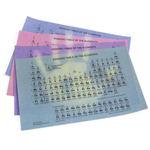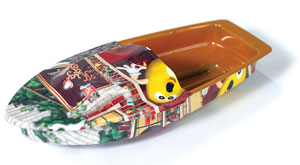September 11, 2009
 by: Ron Perkins
by: Ron Perkins
A short time ago I received the following inquiry regarding our Heat-Sensitive Paper. One of the joys of being the president of Educational Innovations is having the opportunity to answer questions like this.
Q: What chemical coats your Heat-Sensitive Paper that makes it change color? My chemistry class wants to know the chemistry of what is happening on our heat-sensitive periodic tables. Can you please help us?
help us?
A: Some of the characteristics of our heat-sensitive periodic tables are easy to understand and some more challenging. The inks used provide color at lower temperatures and are colorless at higher temperatures. The change over temperature is called the “critical temperature.” Adding heat to the paper causes the paper to loose its color, an “endothermic” reaction. The reverse, going from colorless to colored, is an “exothermic” reaction and returns the heat.
To manufacture this paper, long rolls of white paper are unwound, coated on one side, dried, cut, and finally stacked into reams. Read the rest of this entry »
 5 Comments |
5 Comments |  Chemistry, College level, Elementary level, High School level, Middle School level | Tagged: heat sensitive paper, micro-encapsulation, periodic tables, phenomenon based learning, thermochromic paper, touch-it paper |
Chemistry, College level, Elementary level, High School level, Middle School level | Tagged: heat sensitive paper, micro-encapsulation, periodic tables, phenomenon based learning, thermochromic paper, touch-it paper |  Permalink
Permalink
 Posted by Tami O'Connor
Posted by Tami O'Connor
September 8, 2009
 by: Tami O’Connor
by: Tami O’Connor
Though I am no longer in a traditional classroom, the end of each August still fills me with that feeling of eager anticipation and yes, even a bit of anxiety…. Then I remember, I’m not going to be facing a room filled with bright new faces nor will I need to develop the plethora of creative lesson ideas necessary to engage and stimulate young minds. But still, I enjoy sharing some of the school experiments that my students and I enjoyed.
One school activity I used to teach the scientific method required the use of an old favorite; Sodium Polyacrylate. This is the chemical powder found in disposable baby diapers. I would start my lesson with a 3 Cup Monty game in which I used 3 opaque cups that were identical in every way except that two of the cups were empty and in the third I placed about 3 tablespoons of the water lock powder.
My shtick started with me talking about the importance of observation skills. I would explain the necessity of having a keen eye. Shortly after my speech I would pour about 1/2 of a cup of water into one of the empty cups. While encouraging my students to carefully watch the cup with the water in it, I would move the cups around fairly slowly, knowing they would be able to follow the water filled cup easily, until the three cups ended in a line across my desk. Read the rest of this entry »
 1 Comment |
1 Comment |  Chemistry, Elementary level, experiments, High School level, Middle School level | Tagged: baby diaper experiment, back to school, instant snow, phenomenon based learning, polymers, sodium polyacrylate, water lock |
Chemistry, Elementary level, experiments, High School level, Middle School level | Tagged: baby diaper experiment, back to school, instant snow, phenomenon based learning, polymers, sodium polyacrylate, water lock |  Permalink
Permalink
 Posted by Tami O'Connor
Posted by Tami O'Connor
July 31, 2009
 by: Norman Barstow
by: Norman Barstow
When the National Research Council produced the National Science Standards in 1995, they did so without including sets of lesson plans nor did they design them as part of a standard curriculum package. They were written to be used as goals for our students’ achievement in science.
Read the rest of this entry »
 2 Comments |
2 Comments |  Elementary level, energy, experiments, Middle School level, Physics | Tagged: ballons, compressed air, experiments, force and motion, manipulating variables, National Science Standards, phenomenon based learning, scientific method, STEM |
Elementary level, energy, experiments, Middle School level, Physics | Tagged: ballons, compressed air, experiments, force and motion, manipulating variables, National Science Standards, phenomenon based learning, scientific method, STEM |  Permalink
Permalink
 Posted by Tami O'Connor
Posted by Tami O'Connor
July 24, 2009
 by: Tami O’Connor
by: Tami O’Connor
Let’s face it, kids of every age love gooey substances! The school year is never complete until you and your students make slime. Depending upon your grade level, the topic you’re teaching, your classroom budget, and the time you have available, there are a number of options open to you.
One of my favorite “recipes” is the ever popular Elmer’s Glue Gak. Aside from the fact that it’s easy to make, it’s rare that you wouldn’t have most of the essential ingredients at your fingertips.
To make Gak:
Read the rest of this entry »
 10 Comments |
10 Comments |  Chemistry, Elementary level, experiments, Middle School level | Tagged: Borax, Dr. Seuss, floam, fun experiments, gak, homeschool, non-Newtonian fluid, oobleck, parent friendly, phenomenon based learning, phenomenon-based science, phosphorescent powder, polymers, polyvinyl alcohol, Slime |
Chemistry, Elementary level, experiments, Middle School level | Tagged: Borax, Dr. Seuss, floam, fun experiments, gak, homeschool, non-Newtonian fluid, oobleck, parent friendly, phenomenon based learning, phenomenon-based science, phosphorescent powder, polymers, polyvinyl alcohol, Slime |  Permalink
Permalink
 Posted by Tami O'Connor
Posted by Tami O'Connor
May 28, 2009
 by: Tami O’Connor
by: Tami O’Connor
Although Robert Fulton is usually remembered as the inventor of the steamboat, it was actually John Fitch who built the first successful steamboat in 1787. Unfortunately, John Fitch ran into financial difficulties which opened the door for Robert Fulton to design and test the Clermont, which was the first commercially successful steamboat, in 1807. Since that time, there have been many improvements on the initial design, but the science behind the steamboat engine is fascinating.
Educational Innovations carries Putt Putt Steam Boats that are wonderful reproduction toys, which can be used to teach many scientific principles. The science behind how they work is rather complex and often disputed. Read the rest of this entry »
which can be used to teach many scientific principles. The science behind how they work is rather complex and often disputed. Read the rest of this entry »
 1 Comment |
1 Comment |  College level, Elementary level, experiments, High School level, Middle School level, Physics | Tagged: phenomenon based learning, steamboats, STEM, thermodynamics |
College level, Elementary level, experiments, High School level, Middle School level, Physics | Tagged: phenomenon based learning, steamboats, STEM, thermodynamics |  Permalink
Permalink
 Posted by Tami O'Connor
Posted by Tami O'Connor
 help us?
help us?



 Posted by Tami O'Connor
Posted by Tami O'Connor  by: Tami O’Connor
by: Tami O’Connor by: Norman Barstow
by: Norman Barstow